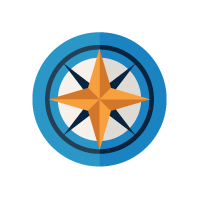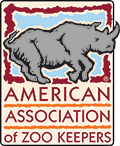|
AAZK—a Case Study in Collaboration
By Gary Priest, Curator of Animal Care Training, San Diego Zoo Global Academy
In the last few newsletters we've been exploring the word, "collaboration." At its very core, the Academy is a collaborative learning environment that is dedicated to advancing animal care, welfare and safety within the zoological profession. This month, we'll focus on one professional organization that is using the Academy platform to reach out and collaborate with their entire membership in some amazing new ways.
The American Association of Zoo Keepers (AAZK) has been a valued Academy partner for several years. The San Diego Zoo Global Academy (SDZGA) and AAZK recently explored ways to enable more animal care professionals, as well as those interested in entering our profession, to be able to access the online training opportunity of Academy courses.
 The result is that AAZK now has their own online training site, "powered" by the San Diego Zoo Global Academy. In other words, it is an "Academy" site, branded as AAZK Online, and is designed to meet the needs of AAZK's 3,000 professional and student member community. This site is available to AAZK members for online activities relevant to their membership, as well as AAZK chapter activities. Within the AAZK Online site, the Course Catalog contains the San Diego Zoo Global Academy classes. As a membership benefit, AAZK members receive individual, or chapter related discounts in order to access the SDZGA courses. The result is that AAZK now has their own online training site, "powered" by the San Diego Zoo Global Academy. In other words, it is an "Academy" site, branded as AAZK Online, and is designed to meet the needs of AAZK's 3,000 professional and student member community. This site is available to AAZK members for online activities relevant to their membership, as well as AAZK chapter activities. Within the AAZK Online site, the Course Catalog contains the San Diego Zoo Global Academy classes. As a membership benefit, AAZK members receive individual, or chapter related discounts in order to access the SDZGA courses.
The amazing thing about collaboration is that it seems to foster innovation where mathematics behave differently to create an environment where 1+1 = 3, or 4, or even 10. AAZK, by collaborating with San Diego Zoo Global Academy, was able to expand online training, which was originally offered exclusively as a benefit to their professional membership, to now include all classes of membership in the organization. Continuing education is offered to AAZK professional members while career advancement training is now available for their student members. In addition, AAZK leadership discovered that the Academy platform could also become a valuable tool for their chapters. AAZK chapters now have access to a branded communications platform for use with their members, between other chapters and with AAZK executive leadership. 1+1= 10.
We are all very pleased by this growing collaboration. The result is an excellent example of collaboration cubed, where (AAZK) + (The Academy) + (Collaboration) = Multiplied Increased Value to three different aspects of AAZK's organizational universe, (professional members, student members, AAZK chapters around the country) while continuing to support the Academy's mission to our community of learners.
But the story doesn't stop with AAZK. Recently, through collaborations with AAZK and others, it became apparent to us that there were more subscription levels the San Diego Zoo Global Academy could offer, so that more institutions could participate. As a result, a new goal for us at the Academy is to get the word out to all of the AAZK member institutions, as well as other institutions, that chances are good that we have an affordable way for you to be able to access San Diego Zoo Global Academy training, too.
The Academy salutes and thanks AAZK's leaders for creatively seeking and finding ways to better leverage the training and communication asset, which is the Academy. Now, through a very fruitful collaboration, AAZK is even better at meeting the expanding and diverse needs of its membership.
For questions, please contact Gary Priest, Curator of Animal Care Training, San Diego Zoo Global Academy, at gpriest@sandiegozoo.org.
|